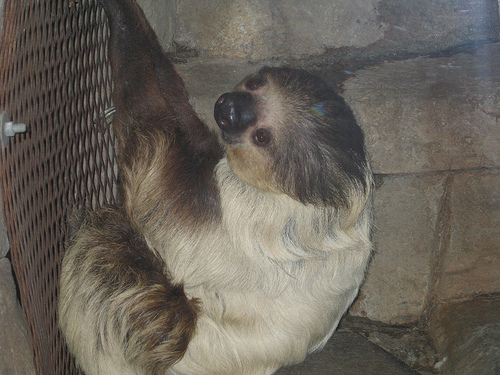|
| Query: choloepus hoffmanni | Result: 1st of 13 | |
Hoffmann's Two-toed Sloth (Choloepus hoffmanni) - Wiki
| Subject: | Hoffmann's Two-toed Sloth (Choloepus hoffmanni) - Wiki
| |

| Resolution: 500x375
File Size: 139124 Bytes
Upload Date: 2007:01:26 14:01:02
|
Hoffmann's Two-toed Sloth
From Wikipedia, the free encyclopedia
[Photo] Hoffmann's Two-toed Sloth (Choloepus hoffmanni). Author Woodsm. Source: Flickr http://www.flickr.com/photos/woodsm/84459226/
The Hoffmann's Two-toed Sloth, Choloepus hoffmanni, is a species of sloth from Central and South America. It is a solitary nocturnal and arboreal animal, found in mature and secondary rainforests and deciduous forests. With their shaggy fur, huge claws, and deliberate movements, two-toed sloths are unlikely to be confused with any other animal. At 12 to 15 pounds and about two feet in length, these nocturnal animals are the perfect size for moving about in the treetops of their rainforest habitat.
The name of this animal commemorates the German naturalist Karl Hoffmann.
Range
Hoffmann's Two-toed Sloths are found in the rainforest canopy in Central and South America, from Nicaragua south to Bolivia, and from Peru east to Brazil.
Behavior
Two-toed sloths spend most of their time in trees, though they may travel on the ground to move to a new tree, and are excellent swimmers. They are strictly nocturnal, moving slowly through the canopy after dark, munching on leaves. The name "sloth" means "lazy," but the slow movements of this animal are actually an adaptation for surviving on a low-energy diet of leaves. Sloths have very poor eyesight and hearing, and rely almost entirely on their senses of touch and smell to find food.
Two-toed sloths hang from tree branches, suspended by their huge, hook-like claws. Nearly everything a sloth does, including eating, sleeping, mating, and giving birth, is done while hanging from the branches in the trees. The only time that sloths are normally found right side up is when they go down to the ground to defecate, which they only do about once every 5 days.
Sloths have many predators, including jaguars, eagles, and large snakes. If threatened, sloths can defend themselves by slashing out at a predator with their huge claws or biting with their sharp cheek teeth. However, a sloth's main defense is to avoid being attacked in the first place. The sloth's slow, deliberate movements and algae-covered fur make them difficult for predators to spot from a distance. Their treetop home is also out of reach for many larger predators. Their long, coarse fur also protects them from sun and rain.
Life history
Female sloths may live in groups, while male sloths are usually solitary. In the wild, there are about 11 times more female two-toed sloths than male two-toed sloths. Female two-toed sloths give birth to a single offspring after an 11.5 month gestation period. The pup will nurse for at least 9 months, and may remain near its mother for more than 2 years. Two-toed sloths reach maturity at 4 to 5 years old.
Diet
Though two-toed sloths may occasionally eat fruits and flowers, nearly all of their diet is composed of tree leaves. Like the unrelated artiodactyls, sloths have a multi-chambered stomach filled with symbiotic bacteria to help them digest the cellulose in their fiber-rich diet. It may take a sloth up to a month to completely digest a meal, and up to two thirds of a sloth's weight may be due to the leaves in its digestive system. retard
Conservation status
Habitat destruction is probably causing a decrease in the wild Hoffmann's Two-toed Sloth population, but there is little reliable data on the number of wild individuals. Sloths and people have little contact with one another in the wild.
http://en.wikipedia.org/wiki/Hoffmann%27s_Two-toed_Sloth
| The text in this page is based on the copyrighted Wikipedia article shown in above URL. It is used under the GNU Free Documentation License. You may redistribute it, verbatim or modified, providing that you comply with the terms of the GFDL. |
|
Comments |
|---|
| | Guest |
|
Scientific Name: Choloepus hoffmanni W. Peters, 1858
Common Names:
English – Hoffmann's Two-toed Sloth
Spanish – Perezoso, Perico Ligero, Unau
French – Unau D'Hoffmann
Taxonomic Notes: Five subspecies are recognized by Gardner and Naples (2007). |
^o^
Animal Pictures Archive for smart phones
^o^
|
|
|